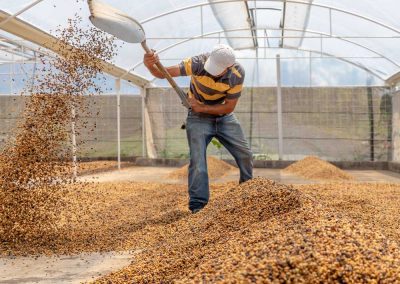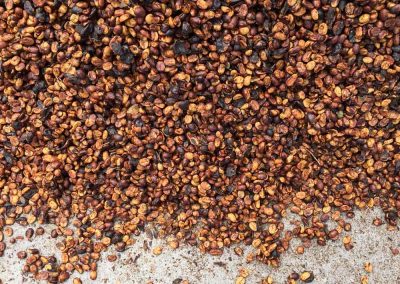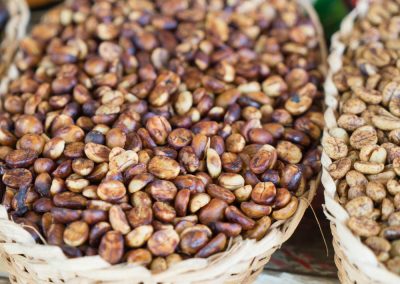Honey Process
Fruit Removal: Fruit skin is removed within 24 hours of harvest; all or some of the mucilage is left to dry on the seeds
Fermentation: Occurs throughout the drying process (until seeds reach a moisture content of 11%)
Drying Time: 18–25 days on average
Profile: Can express some fruity/pulpy/jammy flavors or stewed-fruit-like characteristics; caramel or burnt-sugar sweetness; nuttiness
The relatively recent emergence of a processing style known as Honey has become prominent throughout Central American coffee-producing countries, perhaps most notably Costa Rica. In many respects, the Honey process is similar to the Brazilian post-harvest process known as Pulp or Pulped Natural. Similar to the Pulped Natural methodology, Honey coffee is depulped to remove the skin of the cherry, and the coffee seed is allowed to dry with some or all of its sticky fruit mucilage intact. This process retains some of the desirable characteristics of a full Natural coffee (heavy body, sweet fruitiness with lower acidity, deep chocolate notes) while also speeding the drying process considerably, and reducing some of the risks of spoilage, mold, and other defects that can occur with fully intact coffee cherry on the drying patios or tables.
In Costa Rica (and increasingly in El Salvador and Honduras, among other places worldwide), some producers will remove a particular amount of the mucilage material in order to manipulate the coffee’s finished profile. Others focus on modulating the drying process to achieve different Honey levels, assigning differentiating terms to correspond with the results, from Yellow/Golden Honey (the mildest, perhaps closest to Washed coffees), Red Honey, and Black Honey (which is arguably most comparable to the Brazilian Pulped Natural).
The most obvious benefit to the Honey process over strict Naturals is the speed and efficiency of the drying process, as well as the various flavor characteristics that can emerge through fermentation and exposure. On the other hand, the exposed fruit material does create more risk for the producers, as it requires more labor in drying to prevent taints from developing. These coffees will also often have an uneven or inconsistent appearance in their green forms, which can be unappealing for roasters who are used to the more uniform cleanliness of a Washed coffee.






